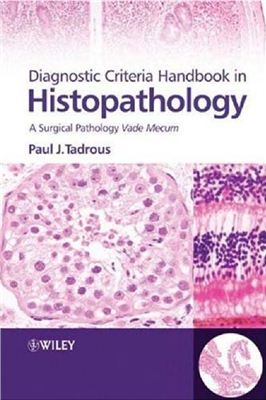John Wiley & Sons Ltd, 2007. – 454 pages.
This book presents criteria for histopathological diagnosis in list form for rapid access. It covers diagnostic surgical pathology, cytology, autopsy practice, histological technique, lab management, RCPath guidance and UK Law relevant to histopathology. Trainees and consultants in diagnostic practice and those needing a quick refresher in preparation for professional exams (such as the MRCPath) should find this book a useful companion.
This book focuses on:
diagnostic criteria for each condition;
immuno profiles of normal cells, tissues and pathological entities where this is helpful;
criteria for malignancy in otherwise benign lesions e.g. what makes a malignant SFT? What are the criteria for malignancy in a pilomatricoma? When should you be worried with an ameloblastoma and when does MGUS become myeloma?
differential diagnoses with notes on distinguishing features e.g. how do you distinguish Kaposi’s sarcoma from Kaposiform haemangioendothelioma or mucoepidermoid carcinoma from adenosquamous carcinoma or epithelioid haemangioendothelioma from epithelioid angiosarcoma or an atypical adenomatous hepatocellular nodule from hepatocellular carcinoma?
definition of terms and quantities needed for diagnosis. For example, what are the size and mitotic count criteria for placing GISTs into malignancy risk categories? What is the definition of vertical and radial growth phases for melanoma? What constitutes an inadequate cervical smear? How big must a focus of atypical adenomatous hyperplasia be before it is considered bronchioalveolar carcinoma? What makes a lymph node metastasis a micrometastasis and how does this differ from ‘isolated tumour cells present’? Many of these have important management implications;
grading, scoring, classification and staging criteria for tumours and non-neoplastic conditions (e.g. transplant rejection, hepatitis, ER and PgR receptor status, spermatogenesis, etc.). No attempt has been made to reproduce the TNM staging system as the UICC book is an excellent handy reference which all pathologists working with tumours should have. Some aspects of TNM have, however been included in this book where it emphasises certain practical points (e.g. in Chapter 4: Cut-Up and Reporting Guidelines). A separate Grading Index page is provided for rapid access to the various schemes (see page xxv);
dating criteria for endometria, myocardial infarction, thrombi and villi (following intra-uterine death);
normal values and ranges e.g. for PM weights, placental weights, weight ratios, mitotic counts, etc;
laboratory methods are covered from a pathologist’s perspective;
laboratory management (health and safety, UK legislation and govement initiatives, budgetary control, Clinical Goveance, etc.) and summary guidance from the RCPath National Datasets for Reporting Cancers, cut-up, autopsy practice and reporting major types of specimen together with handy anatomical diagrams;
frozen section diagnosis –a separate ‘Frozen Section Index’ (see page xxvi) points to advice for peroperative diagnosis in all the chapters for rapid access to this information;
mnemonics and general advice in exam technique are offered for MRCPath exam candidates.
This book presents criteria for histopathological diagnosis in list form for rapid access. It covers diagnostic surgical pathology, cytology, autopsy practice, histological technique, lab management, RCPath guidance and UK Law relevant to histopathology. Trainees and consultants in diagnostic practice and those needing a quick refresher in preparation for professional exams (such as the MRCPath) should find this book a useful companion.
This book focuses on:
diagnostic criteria for each condition;
immuno profiles of normal cells, tissues and pathological entities where this is helpful;
criteria for malignancy in otherwise benign lesions e.g. what makes a malignant SFT? What are the criteria for malignancy in a pilomatricoma? When should you be worried with an ameloblastoma and when does MGUS become myeloma?
differential diagnoses with notes on distinguishing features e.g. how do you distinguish Kaposi’s sarcoma from Kaposiform haemangioendothelioma or mucoepidermoid carcinoma from adenosquamous carcinoma or epithelioid haemangioendothelioma from epithelioid angiosarcoma or an atypical adenomatous hepatocellular nodule from hepatocellular carcinoma?
definition of terms and quantities needed for diagnosis. For example, what are the size and mitotic count criteria for placing GISTs into malignancy risk categories? What is the definition of vertical and radial growth phases for melanoma? What constitutes an inadequate cervical smear? How big must a focus of atypical adenomatous hyperplasia be before it is considered bronchioalveolar carcinoma? What makes a lymph node metastasis a micrometastasis and how does this differ from ‘isolated tumour cells present’? Many of these have important management implications;
grading, scoring, classification and staging criteria for tumours and non-neoplastic conditions (e.g. transplant rejection, hepatitis, ER and PgR receptor status, spermatogenesis, etc.). No attempt has been made to reproduce the TNM staging system as the UICC book is an excellent handy reference which all pathologists working with tumours should have. Some aspects of TNM have, however been included in this book where it emphasises certain practical points (e.g. in Chapter 4: Cut-Up and Reporting Guidelines). A separate Grading Index page is provided for rapid access to the various schemes (see page xxv);
dating criteria for endometria, myocardial infarction, thrombi and villi (following intra-uterine death);
normal values and ranges e.g. for PM weights, placental weights, weight ratios, mitotic counts, etc;
laboratory methods are covered from a pathologist’s perspective;
laboratory management (health and safety, UK legislation and govement initiatives, budgetary control, Clinical Goveance, etc.) and summary guidance from the RCPath National Datasets for Reporting Cancers, cut-up, autopsy practice and reporting major types of specimen together with handy anatomical diagrams;
frozen section diagnosis –a separate ‘Frozen Section Index’ (see page xxvi) points to advice for peroperative diagnosis in all the chapters for rapid access to this information;
mnemonics and general advice in exam technique are offered for MRCPath exam candidates.

